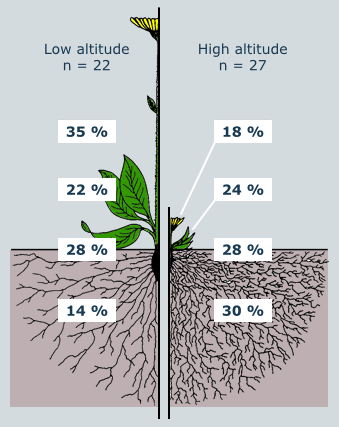Carbon investment in alpine plants - carbon allocation

Since the rate of photosynthetic CO2 uptake (source activity) is equal to or higher and the rate of respiratory loss of CO2 is equal to or lower than in lowland plants, alpine plants are commonly not short in photoassimilates. As a result alpine plants store a lot of starch and lipids. In many cases these storage reserves are even shed with senesced leaves.
The rate of leaf photosynthesis and respiration are thus insufficient to explain the whole plant's carbon balance. A key question is the relative abundance of leaf vs. non leaf tissue. How do alpine plants invest their photoassimilates?
For a broad sample of alpine herbaceous species from the Andes, the Alps and the Scandes the surprising result was that they do not differ in this respect from lowland plants. On average, alpine and lowland forbs invest 21-24 % of their dry matter (the so-called leaf mass fraction) in green leaves, but there is a large species to species variation across species which do equally well in a given alpine habitat.
Remember: More storage carbohydrates and lipids - no difference in the investment of biomass into photosynthetic organs.
Together with the evidence for leaf photosynthesis and respiration these observations suggest that alpine plants have no particular problem with carbon acquisition. There must be other reasons why alpine plants grow slowly and stay small.
Guess: What might be limiting growth if carbon supply is not?
-
source activity
-
sink activity

